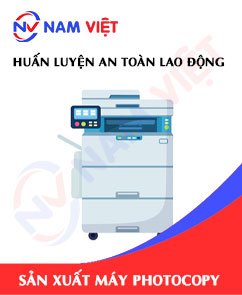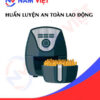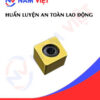Occupational Safety Training in Photocopier Manufacturing
99,000 ₫
Note: The above price is calculated for one person, the price may fluctuate depending on the number of trainees participating in the course and depending on market movements. For more accurate pricing support, please refer to the quotation table or contact our consulting staff directly.
Occupational safety is an important issue in photocopier manufacturing factories and needs to be addressed promptly to ensure the health and safety of workers, and to enhance the reputation of businesses. The Occupational safety training course is one of the effective solutions to raise awareness about accident prevention for workers participating in photocopier manufacturing.
Table of Contents
Toggle1. Overview of Photocopiers
a. What is a Photocopier?
A photocopier (also called a copying machine) is an office device used to duplicate paper documents using photocopy technology. When you place a document in the photocopier and press the copy button, the machine uses light to create a copy of the document on a new sheet of paper.
Photocopiers are commonly used in offices, libraries, schools, and government agencies.

b. Types of machinery for Photocopier production
The machinery used in photocopier production includes:
- Toner press machine: Used to produce toner powder, an essential component of a photocopier.
- Metal cutting and bending machine: Used to produce metal parts in photocopiers such as rollers, fan shafts, ink tubes, etc.
- Embossing machine: Used to print letters and symbols on plastic and metal parts in photocopiers.
- Plastic processing machine: Used to manufacture plastic components such as drives, ink tubes, etc.
- Packaging machine: Used to pack photocopier parts and components for transport and assembly.
- Inkjet machine: Used to manufacture parts related to the printing process such as print heads and print head drives.
- Software configuration machine: Used to install software and firmware for photocopiers.
These machines are designed to automate production processes to increase productivity and reduce production time.

c. Photocopier manufacturers in Vietnam
Popular photocopier brands on the market today include:
- Canon: One of the largest brands in the photocopier industry, especially office models. Canon products are durable and consistently high-quality.
- Xerox: One of the oldest brands in the photocopier field, known for high-quality products, particularly color photocopiers.
- Ricoh: Famous for multifunction photocopiers, often with elegant design and excellent print quality.
- HP: A major brand in printers and photocopiers, with attractive design, smart features, and ease of use.
- Toshiba: Known for industrial photocopiers with high durability and good print quality.
Other brands include Sharp, Konica Minolta, Kyocera, Brother, Panasonic, Epson, Lexmark, etc.

d. Specific jobs in Photocopier manufacturing factories
Group 1
- Executive directors, deputy directors, and department heads in photocopier manufacturing factories.
Group 2
- Safety officers: manage safety in the factory, design safety procedures, supervise and enforce compliance with safety regulations.
Group 3
- Fabrication: Uses tools and equipment to produce photocopier components, including electronic parts, printing parts, and other components.
- Assembly: Assembles produced components into complete photocopiers.
- Quality inspection: Ensures all photocopiers operate properly and meet quality standards.
- Packing and shipping: Packages photocopiers and sends them to customers or distributors.
Group 4
- Office work, service, sales, marketing.
- Production management, quality management, human resources management, material management, financial and accounting management.
- Design: Creates technical drawings for photocopiers, including components, parts, and software.

2. Overview of Occupational Safety Training for Photocopier Manufacturing
This article focuses on issues related to Group 3, because Group 3 directly participates in production and faces the highest occupational safety risks. For other groups, refer here.
a. What is Group 3 Occupational Safety Training?
- Group 3 Occupational Safety Training provides workers with awareness and methods to prevent workplace accidents.
- The training helps workers recognize hazards and avoid risks that may lead to accidents during work.
REGISTER FOR OCCUPATIONAL SAFETY TRAINING SERVICE
b. Training duration
Initial Occupational Safety Training
- Total training time is at least 24 hours, including exam time.
- 8 hours of theory on safety policies and labor hygiene laws
- 8 hours of theory on basic occupational safety and hygiene knowledge
- 4 hours of theory on specialized training content
- 2 hours of practical training on specialized content
- 2 hours of final theoretical exam
Safety training centers schedule multiple sessions depending on workers’ availability. Typically, there are 6 sessions over 3 days, if the company arranges continuous training time.
Periodic Safety Training
- Before the occupational safety card expires, workers seeking renewal must undergo periodic occupational safety training with a training duration of at least 50% of the initial training time.
Explanation: Total periodic training is at least 12 hours, including exams. After completing the training and passing the exam, workers are reissued an occupational safety card.
c. Training content
| No. | TRAINING CONTENT | TRAINING TIME (HOURS) | |||
| Total | Including | ||||
| Theory | Practice | Exam | |||
| I | Occupational Safety Policies and Laws | 8 | 8 | 0 | 0 |
| 1 | Overview of regulations on occupational safety and hygiene. | 6 | 6 | ||
| 2 | Standards and technical regulations on occupational safety and hygiene. | 1 | 1 | ||
| 3 | Specific regulations from government agencies regarding new construction, expansion, or renovation of facilities, and management of machines, equipment, and hazardous substances. | 1 | 1 | ||
| II | Basic Occupational Safety Knowledge | 8 | 8 | 0 | 0 |
| 1 | Basic knowledge of hazards and risks in the workplace. | 4 | 4 | ||
| 2 | Methods to improve working conditions. | 1 | 1 | ||
| 3 | Safety culture in production and business. | 1 | 1 | ||
| 4 | Rights and responsibilities of employers and employees; occupational safety policies; roles of safety officers. | 1 | 1 | ||
| 5 | Occupational safety rules, signs, personal protective equipment, first aid, and prevention of occupational diseases. | 1 | 1 | ||
| III | Specialized Training Content | 6 | 4 | 2 | 0 |
| Comprehensive knowledge of machines, equipment, hazardous substances; risk analysis and management; safe working procedures. | 6 | 4 | 2 | ||
| IV | Final Exam on Occupational Safety Training | 2 | 2 | 0 | 0 |
| Total | 24 | 22 | 2 | ||
See more training content for all 6 groups
d. Occupational Safety Card
After completing the occupational safety training and passing the exam, workers are issued an Occupational Safety Card (commonly called Occupational Safety Certificate for Group 3).
The Group 3 card clearly displays information such as full name, date of birth, job, working environment, training duration, red stamp, and signature confirming course completion.
According to Clause 2 of Article 24, Decree 44/2016/ND-CP, there are 2 cases:
- If the employer and employee have a labor contract, the employer must sign, stamp, and seal the card after the worker completes training and passes the exam.
- If the worker is freelance or temporary with no labor contract, the training unit must sign, stamp, and seal the card after the worker completes training and passes the exam.

3. Identifying Hazards Affecting Workers During Photocopier Manufacturing
Common hazards in the photocopier manufacturing process may include:
- Collision and impact hazards: Employees may be injured when moving heavy equipment or working with fast-running machinery.
- Fire and explosion hazards: Electrical devices may short-circuit or explode if not used properly.
- Chemical toxicity: Employees may be exposed to harmful chemicals used in photocopier production, such as cleaning chemicals and printing inks.
- Temperature and humidity: Employees must work in an environment with controlled temperature and humidity to ensure safety and product accuracy.
- Dust and noise: Employees may work in environments with high dust and noise levels, affecting health and concentration.
- Electrical hazards: If electrical equipment in the factory is not regularly maintained, lacks proper insulation, or is not waterproofed, it can pose an electric shock risk to workers during production.

4. Common Workplace Accidents for Workers in Photocopier Manufacturing
Common workplace accidents in the photocopier manufacturing process include:
-
- Machinery accidents: Risk of injury from collisions, cuts, ejections, crushing, melting, or being crushed while working with machinery.
- Chemical accidents: Risk of burns or scalds from exposure to chemicals used in photocopier production.
- Electrical accidents: Risk of electric shock or injury from exposure to high voltage during photocopier production.
- Toxic gas accidents: Risk of poisoning from exposure to toxic gases such as CO2, CO, O2, NO2 during production.
- Material-related accidents: Risk of injury from handling materials such as paper, ink, and chemicals.

5. Safety Measures When Participating in Photocopier Manufacturing
Safety measures when participating in photocopier manufacturing include:
- Ensure machine and equipment safety: Machinery and equipment must be inspected regularly to ensure proper operation and prevent hazards. Protective measures, such as hand guards and light shields, should also be used.
- Occupational safety training: Employees must receive comprehensive training on occupational safety and health, especially on the correct use of machinery and equipment.
- Use safe materials: Materials used in photocopier production must be checked and ensured to be safe for worker health.
- Ensure hygiene safety: Maintaining hygiene in the production facility is important to prevent health risks, especially when producing small and easily contaminated components.
- Use personal protective equipment: Protective equipment, such as masks, gloves, and safety shoes, should be used when necessary to protect workers from hazardous chemicals, flammable substances, or sharp objects.
- Regularly inspect and maintain machinery and equipment: Machinery and equipment must be checked periodically to ensure proper operation and safety. Maintenance and repair are also crucial for safe production.
- Periodically conduct workplace environment monitoring in factories, collecting and analyzing harmful factors affecting workers, thereby adjusting and reducing risks to prevent occupational diseases.
6. Benefits of Occupational Safety Training in Photocopier Manufacturing
An Toan Nam Viet provides your business with the following benefits after completing occupational safety training in accordance with Decree 44/2016/ND – CP on Occupational Safety and Hygiene for companies and factories:
- Workers can identify potential workplace accident hazards and take preventive measures to avoid accidents.
- Your company can establish risk prevention measures in production, operation, and maintenance processes.
- Reduce costs associated with workplace safety incidents.
- Uninterrupted production increases labor productivity and product quality.
- Comply with labor safety laws, reducing legal risks.
- Enhance credibility and professionalism, thereby elevating your business’s brand.
An Toan Nam Viet’s training programs are solutions to prevent and protect individuals from external hazards that could lead to injuries or, in severe cases, fatalities.
REGISTER FOR OCCUPATIONAL SAFETY TRAINING SERVICE
7. Customer Feedback After Completing Occupational Safety Training in Photocopier Manufacturing
An Toan Nam Viet has many years of experience accompanying businesses across Vietnam, especially in the southern provinces. This responsibility is invaluable to us, which is why our Occupational Safety Training is continuously becoming more professional. The motivation behind An Toan Nam Viet’s growth comes from positive feedback and suggestions from our partners. Below are some testimonials from our clients:
Bac Nam E&C Investment and Construction Joint Stock Company
“My first experience with An Toan Nam Viet was impressive due to the 24/7 support from the consulting team. The class organization was fast and convenient for our company. Thank you very much for Nam Viet’s service!”
Hoa Dat Construction and Trading Joint Stock Company
“Nam Viet’s service greatly helped us simplify occupational safety and complete safety documentation for our work process. The consulting team responded promptly to our inquiries. Five stars for Nam Viet.”
See more customer interviews after using services from An Toan Nam Viet
8. Occupational Safety Training Capacity of An Toan Nam Viet
An Toan Nam Viet is a reputable and quality center for occupational safety training in Vietnam. Our training sessions are continuously held at factories, workshops, or construction sites across the country (all 63 provinces in Vietnam).
REGISTER FOR OCCUPATIONAL SAFETY TRAINING SERVICE
Occupational safety training license
- An Toan Nam Viet has been inspected and certified by the Department of Safety under the Ministry of Labor – Invalids and Social Affairs and granted a certificate of eligibility for occupational safety and hygiene training. This further reinforces our training capacity.

Training materials and lectures
- Before being applied to occupational safety training courses, all materials are reviewed to ensure knowledge accuracy and effective application.
- The teaching methods of instructors follow An Toan Nam Viet standards, developed by experts in occupational safety and hygiene training to maximize knowledge retention for trainees.
Facilities
- Controlling classroom factors affecting training increases teaching efficiency and knowledge absorption for trainees.
- Our training support facilities provide spacious classrooms meeting standards for area, lighting, and training equipment.
9. Nationwide Reputable and Quality Occupational Safety Training Center
At An Toan Nam Viet, we always prioritize the professional dedication of occupational safety training. For us, imparting knowledge to help workers protect themselves is contributing to building the country.
To ensure effective training, we meticulously prepare every detail, no matter how small—from tools, teaching equipment, to curriculum, materials, sound, and lighting.
Our occupational safety instructors are experts with many years of experience. They also have research works identifying hazards across industries and methods to prevent them.
Lectures are derived from practical experience and delivered in an engaging, easy-to-understand manner. These factors help workers stay comfortable during training and absorb knowledge efficiently. The knowledge provided always complies with Decree 44/2016/ND-CP.
As a result, workers learn various preventive measures and how to protect themselves, applying them appropriately in real work situations.
Our training center is proud to provide professional and reputable occupational safety training with the following advantages:
- Competitive training costs while maintaining quality.
- Flexible training schedules compatible with company production activities.
- Fast and legal-compliant certification procedures for occupational safety training.
- Instructors with many years of professional experience.
- Classrooms controlled for factors affecting training efficiency and knowledge retention.
- Lectures designed to suit occupational safety work in companies.
- An Toan Nam Viet works dedicatedly and professionally to provide accurate and fast support to clients.

10. Additional References for Occupational Safety Training in Photocopier Manufacturing
- Occupational Safety Training Material Set
- Occupational Safety Training Materials for Photocopier Manufacturing
- Occupational Safety Training Test Set
- Photocopier Manufacturing Occupational Safety Training Curriculum
- Photocopier Manufacturing Occupational Safety Multiple-Choice Test
1 review for Occupational Safety Training in Photocopier Manufacturing
No comments yet















namchinh.haiphong341
Đơn vị an toàn lao động uy tín tại Việt Nam nhé!